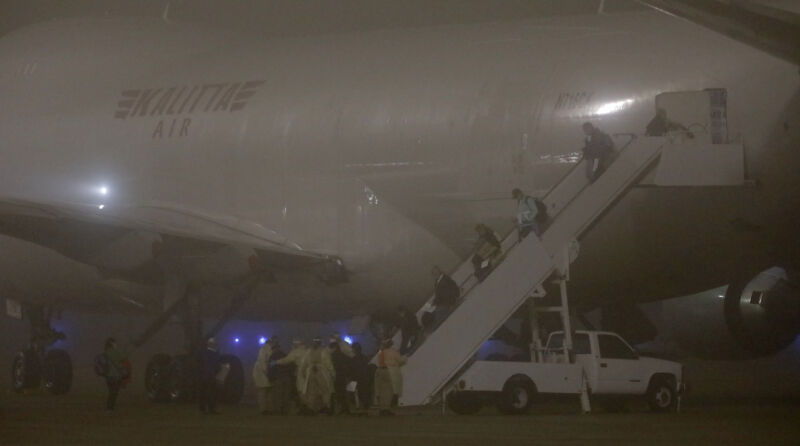
Fourteen Americans tested positive for carrying the new coronavirus just as they began their return to the United States from Yokohama, Japan, where they had been trapped aboard the luxury cruise ship Diamond Princess in a quarantine that began February 3.
As of today, February 17, Japanese health officials have confirmed 454 cases of COVID-19 on the ship, including 99 cases reported since yesterday. The cluster is, by far, the largest of any COVID-19 flare ups outside of China, where the outbreak began and has caused the vast majority of infections and deaths.
The new cases in the returning Americans will nearly double the current number of COVID-19 cases in the US, bringing the total from the current 15 to 29.
Originally, no American cruise ship passengers infected with the new coronavirus were meant to leave Japan. When the US government announced plans on Saturday, February 15, to evacuate the roughly 400 Americans stuck on the cruise liner, it noted that sick passengers would stay in Japan for treatment.
But evacuation plans for over 300 other Americans were thrown into question as they disembarked the ship and made their way on buses to the airport where planes chartered by the US State Department awaited them. En route, US officials received the results of testing done two to three days earlier that determined that 14 of the evacuees were infected with the novel coronavirus.
After some deliberation, US officials decided to allow the 14 travelers—who were asymptomatic as they disembarked the ship—to return to the States. The 14 flew back in a specialized containment area on the evacuation aircraft, isolating them from the other evacuees.
Thrown together
All returning ship passengers would be held in a 14-day federal quarantine in one of two military bases upon their arrival today.
According to reports, 44 Americans tested positive for the virus and did remain in Japan. Others reported that they opted to stay on the ship and take their chances—a decision that may seem wise in retrospect.
Sacramento resident Matthew Smith, a passenger on the Diamond Princess, told CNN affiliate KOVR that he and his wife "decided we would just face whatever consequences [on the ship] rather than exposing ourselves to that [evacuation] situation."
"It kind of didn't make any sense—if the US was fearful that these were infected people, which is why they're going to quarantine them for another two weeks—to have thrown them all together."
The messy evacuation highlights the difficulty of controlling the spread of the COVID-19—particularly on a cruise ship—as many infected with the novel coronavirus show mild to no symptoms. At the same time, hundreds of passengers who disembarked another cruise ship, the MS Westerdam in Cambodia, were being tracked after an 83-year-old American woman formerly aboard tested positive for the virus in Malaysia.
Unpredictable
In a daily situation report today, experts at the World Health Organization noted that the latest data from more than 44,000 cases in China indicates that more than 80 percent of people infected have no more than mild disease and recover fully. Approximately 14 percent of infected have severe disease, including shortness of breath and pneumonia, and 5 percent have critical cases, involving respiratory failure, organ failure, and septic shock. The virus appears to be fatal in about 2 percent of cases in China, with the risk of death increasing with the age of the patient.
There are currently over 71,000 laboratory-confirmed and clinically diagnosed cases worldwide, with 1,775 deaths. Of the cases, 794 are outside of China, scattered in 25 countries. Of the deaths, three have occurred outside of China.
While the daily number of new cases has declined recently in China, WHO Director-General Tedros Adhanom Ghebreyesus cautioned that the trend "must be interpreted very cautiously."
"It's too early to tell if this reported decline will continue," he said. "Every scenario is still on the table."
It is likely that mild cases are underreported and that case tracking will become increasingly more difficult and complex.
Officials in the United States have said repeatedly that current quarantine efforts and travel restrictions are not intended to try to seal off the country from the virus—such an effort would be futile. Instead, the measures are intended to buy additional preparation time to ready for the likely scenario that cases will continue to arrive in the country.
reader comments
116